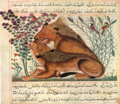| Manafi'-i hayavan | |
|---|---|
| Pierpont Morgan Library, New York | |
| Date | 1297–1299 |
| Place of origin | Maragheh, Iran |
| Language(s) | Persian |
| Scribe(s) | Ibn Bukhtishu |
| Patron | Ghazan |
| Size | 355 mm × 280 mm (14.0 in × 11.0 in); 86 leaves |
| Script | |

Morgan Library, MS M.500 is a 13th-century illuminated manuscript of the Manafi'-i hayavan ("The Benefits of Animals") of Ibn Bukhtishu (980–1058). It was commissioned in 1297–1299 by the Mongol ruler Ghazan. It is written in Persian, and is one of the earliest known examples of the "metropolitan style" of the Mongol Ilkhanid court, together with the 1290 Tarikh-i Jahangushay. It is now in the Pierpont Morgan Library in New York.
Background information
The manuscript ‘Manafi'-i hayavan' is one of the earliest surviving illustrated manuscripts from the reign of Ghazan. The colophon states that it was written in Maragheh, Iran, in 699 or 697 H. The original text was composed in Baghdad. Following that the manuscript was translated into Persian by ʻAbd al-Hādī ibn Muḥammad ibn Maḥmūd ibn Ibrahīm al-Marāghī following the command of the Mongol ruler of Iran Ghazan (ruled 1295-1304). This copy is most probably the original copy which is still preserved in the Pierpont Morgan Library in New York.
Paintings
The paintings of this manuscript ‘Manafi'-i hayavan’ have a distinctive style. They consist of animals set among stylized landscape features. The trees and water are not directly drawn from nature, instead, they are composed of stylized vegetation that is placed in a decorative pattern on the stems. Additionally, the majority of the miniatures in the Morgan Library are framed, and the background vegetation is depicted with scant naturalism. Most paintings reflect earlier Mesopotamian and Arab styles but several also display a new feature, Chinese influence.
Arab style paintings
The horizon in Figures 1-2 consists only of a grassy ground, and the background shows stylized trees as well as birds, which are common in earlier Arab paintings. However, the animal bodies in both paintings are drawn in a more calligraphical, naturalistic Chinese style painting.
-
 Figure 1. Two elephants, Manafi'-i hayavan in the background, birds in flowering plants, by Ibn Bakhtishu, 1295. The Morgan Library and Museum, NY
Figure 1. Two elephants, Manafi'-i hayavan in the background, birds in flowering plants, by Ibn Bakhtishu, 1295. The Morgan Library and Museum, NY
-
 Figure 2. Seated lion behind reclining lioness, Manafi'-i hayavan, from the Bestiary of Ibn Bakhtishu, Maragha, 1298
Figure 2. Seated lion behind reclining lioness, Manafi'-i hayavan, from the Bestiary of Ibn Bakhtishu, Maragha, 1298
Chinese influence

Persian painting now started to use a technique that was previously common in China in which the frame cut off elements within it, as if looking through a window. An example of this can be found in "A mare followed by a stallion," from 'Manafi'-i hayavan’, 1297–1299, Maragha. (Figure 3). Unlike earlier Arab paintings, the frame now cuts off the scene from the viewer. Other Chinese influences include the use of multiple horizons and the detailed depiction of the knotted trunk of the tree.
References
- "Manāfiʻ-i ḥayavān [Benefits of animals]". CORSAIR Online Collection Catalog. The Morgan Library & Museum.
Description: 86 leaves (15 lines), bound : paper, ill. ; 355 x 280 mm
- Bloom, Jonathan; Blair, Sheila (14 May 2009). Grove Encyclopedia of Islamic Art & Architecture: Three-Volume Set. OUP USA. ISBN 978-0-19-530991-1.
Further reading
- Sheikh, S. Z. (2017). Chinese Influence in Persian Manuscript Illustrations. Int. J. of Multidisciplinary and Current research, 5. (pp. 860-861)
- Book: Basil Gray, Persian Painting, 1930 (pp. 20-23)